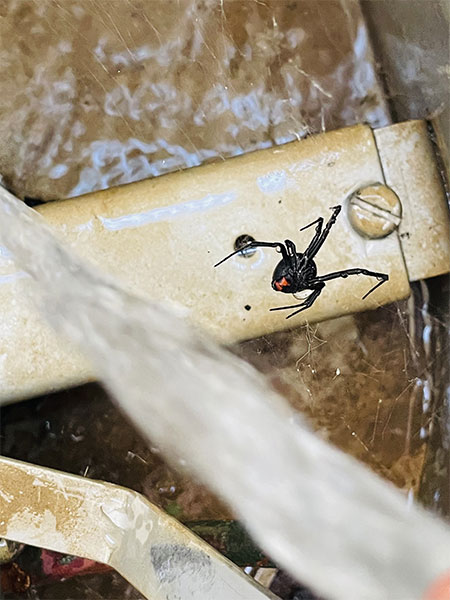
I was working as a zookeeper for the then San Diego Wild Animal Park in the bontebok yard. While caring for these African antelope, I stooped down to clean the water dispenser. This automatic drinker held a metal bowl, roughly one foot wide within an enclosed metal base. Under this bowl was the metal frame that suspended the bowl above the mechanism that automatically refilled the water. It was dark, damp and an ideal place for black widow spiders.
On this particular day, I removed the bowl from its base and spied a spectacularly huge black widow lurking between the drinker housing and the metal frame. “Damn!”, I thought. Nearly every time I’ve tried to get rid of a black widow, it’s been a fruitless fight. Their webs are so messy, stretching every which way, and they are so vigilant and fast that my clumsy attempts to kill them usually result in their escape. In this case, her web was wide across the drinker housing, and her size was intimidating. I considered replacing the bowl and walking away, but what kind of keeper would I be if I left her there in the drinker where these bontebok dipped their soft noses to drink. “Damn!”
That’s when it happened, that thought about respect for all life, regardless of taxa. Why was I being so negative in my thoughts? She was just making her living, and she picked a fine spot for it too. It was likely that she and the bonteboks already cohabitated without conflict. Still. I wanted her out of that drinker. I wondered what would happen if I just asked her.
Historically, every widow spider I’d gone after had successfully fled when I touched the web. I wondered if it was the vibration on the silk, or my clearly broadcasted intention to kill. Either way, I would not be able to lift her out without touching the web. Furthermore, my rake was too wide to fit in the drinker housing if I chose to use it as a weapon. Clearly, she had made a good choice of housing. If I was going to succeed in relocating her, I was going to need her help.
I had recently learned a technique by author and animal communicator Amelia Kinkade called a sandwich technique. Imagine one piece of bread representing the outcome you want to achieve, while the filling is the outcome you are trying to avoid, followed by the second slice of bread, the outcome you want. I had already been successful using the technique to shift animals on and off habitat and I wondered if it would work with this spider. Committing to try, I first mentally introduced myself while marveling at her impressive size and beauty. I acknowledged her fine choice of residence but explained my duty and concern for the bontebok. Then, I tried the sandwich technique.
I carefully imagined placing my rake’s tines inside the lip of the drinker housing, then pictured her choosing to walk toward the tines, climbing off her web and onto the rake. I then pictured moving the rake gently from the drinker over to an elevated planter filled with shrubs and leaf litter. I imagined her calmly disembarking from her rake-ride into the branches of the nearest shrub, unhurt and free to go about her business. I then capped it with a visualization of her thriving there with a sturdy web, complete with a waiting snack. Bread, check! I then moved to the filling, the dreaded scenario of her hiding under the rim and me forcibly trying to remove her, likely causing terrible bodily harm. Finally, I reviewed the bread and the peaceful and cooperative relocation to the planter, gratitude and blessings abound.
With the mental work done, I proceeded to enact my plan, dipping the edge of my rake into the drinker housing. To my utter shock and amazement, I watched this formidable spider leave her web and walk onto my rake! Once she was clearly on the tines, I carefully lifted her out and over to the planter, gently pausing in the shrub to allow her to dismount at her own pace. Once safely in the branches, I thanked her profusely for her graceful cooperation, and for the profound lesson she had just taught me.
Since that day, I have never willfully killed a spider, regardless of species. I have moved countless widow spiders of all ages and colors, including a young brown widow I misidentified and had moved with my bare hands. (Another learning experience in correct identification!) I now have a reputation at work and home as a spider friend and the person to call if a relocation is needed. From that single communication, I learned to extend respect to species I was not previously comfortable with while learning the power of asking before doing. It never hurts to ask. You just might be surprised by the answer!
